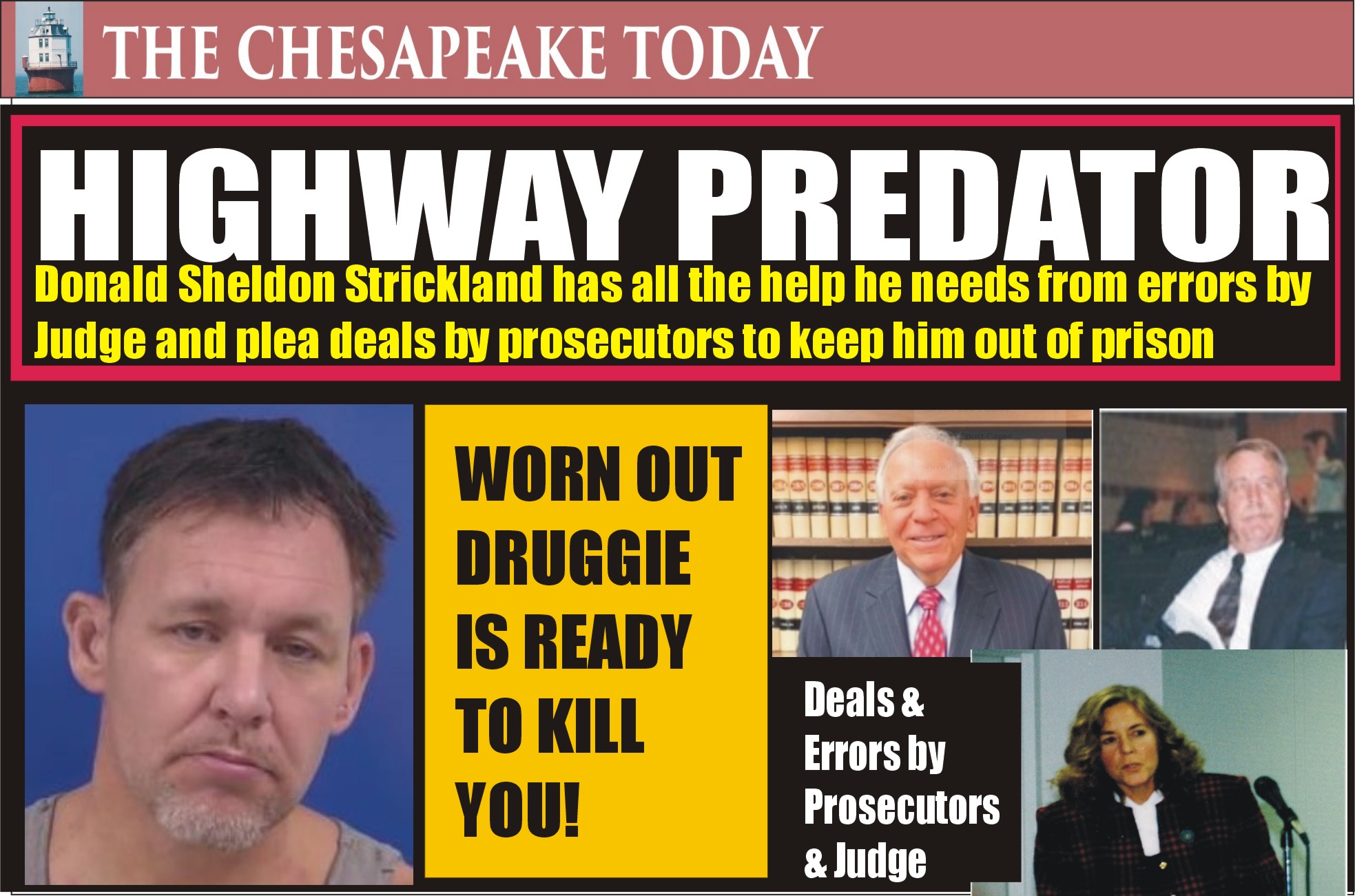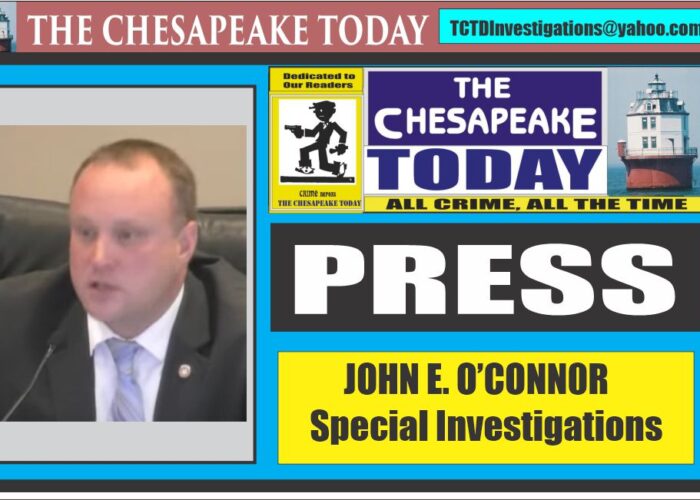
FAIL TO JAIL: Judge’s screwup fouls long prison sentence for Highway Predator Donald Strickland; new drug arrests while driving may keep him in slammer for a while longer
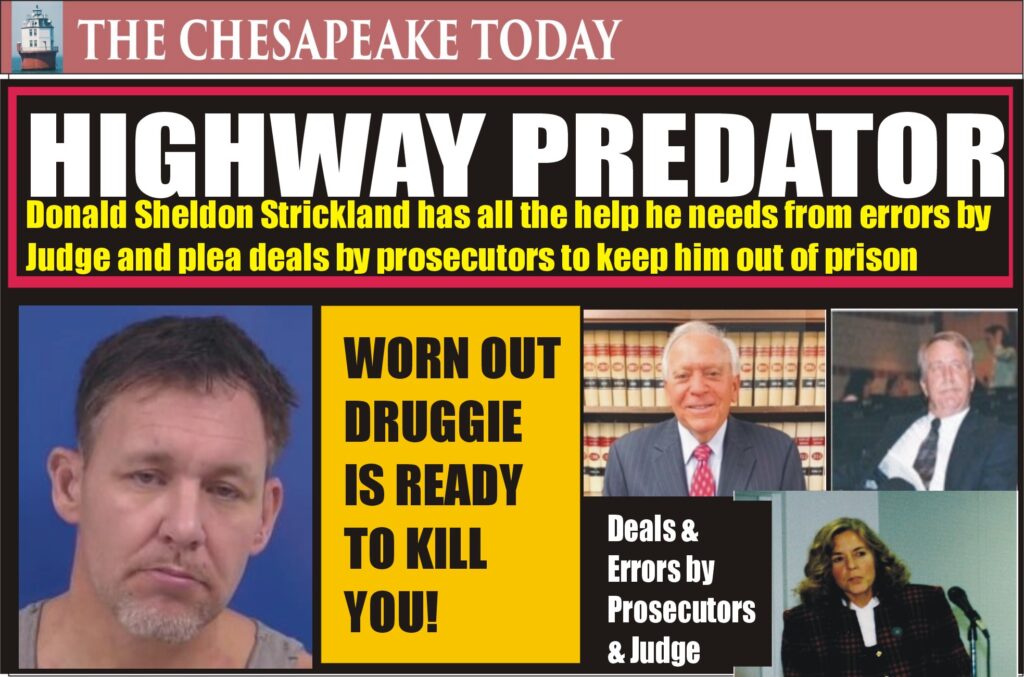
LUSBY, MD. – One of the career criminals of Southern Maryland has been arrested again on drug and alcohol-related traffic charges, this latest arrest took place on Christmas Eve when a Calvert Sheriff Deputy found Donald Sheldon Strickland swerving over the center line and nearly hitting another vehicle.
Calvert Sheriff Mike Evans reports that on December 24, 2021, Calvert County Sheriff’s Department Cpl. Pounsberry responded to Rt. 4 and Southern Connector in Lusby, MD for a report of a traffic complaint.
Cpl. Pounsberry observed the suspect vehicle allegedly swerve across the center line nearly striking another vehicle.
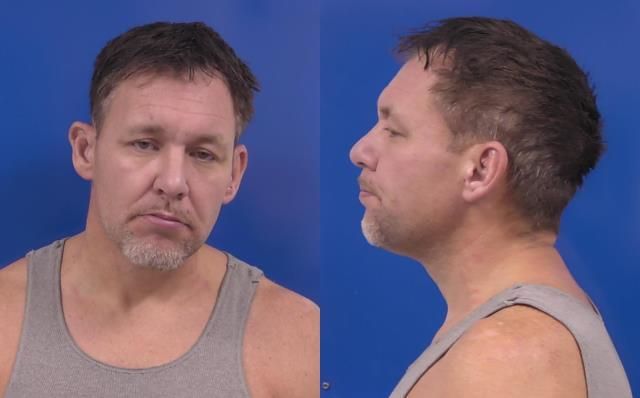
A traffic stop was conducted and the driver, Donald Sheldon Strickland, 42, (DOB: 04/25/1979) of 46033 Strickland Road, Great Mills, Md, failed to produce identification or a driver’s license.
Police say that a vehicle search revealed several controlled dangerous substances to include pills of Gabapentin, Amphetamine, Dextroamphetamine, Alprazolam, a loaded syringe containing suspected heroin, 2 metal containers of suspected heroin, multiple metal spoons and syringes, a glass smoking device with suspected crack cocaine and a plastic bottle containing urine.
Strickland was placed under arrest and transported to the Calvert County Jail.
COPS SAY THEY FOUND DRUGS ON HIS PERSON AT THE HOTEL CALVERT
Police say that a search of Strickland’s person upon entering the Calvert County Jail allegedly revealed a Suboxone strip and a plastic baggie of heroin. Strickland was charged with CDS: Possession-Not Marijuana (4x) and Altering a Drug/Alcohol Test.

Court records show that Strickland’s sentence to spend ten years in prison was amended in 2019 and probation was granted with strict terms that prohibit Strickland from possession of guns, drugs or any type of narcotics and paraphernalia and that he must obey all laws.
Strictly Oxy Strickland Takes His Pickup With Him To Slammer
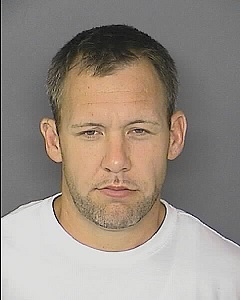
Court records show that on September 24, 2019, Strickland was released from prison and given a new trial after the Maryland Court of Special Appeals reversed his conviction due to errors made in the trial by Circuit Court Judge Karen Abrams.
ARSON THREAT
A criminal charge of making an arson threat was filed in St. Mary’s Circuit Court on October 19, 2021, by the St. Mary’s States Attorney Richard Fritz. Leonardtown attorney Daniel Slade has filed representation for Strickland with a jury trial set for February 23, 2022.
NEW VIOLATION OF PROBATION HEARING IN ST. MARY’S CIRCUIT COURT
Following a hearing in St. Mary’s Circuit Court before Circuit Court Judge Densford, he was sent back to the slammer on December 18, 2020.
STATES ATTORNEY BOB HARVEY CUTS A PLEA DEAL
Calvert County States Attorney Robert Harvey agreed to a plea deal for Strickland in Calvert District Court on December 14, 2021. Strickland entered a guilty plea to possession of drugs other than pot and was sentenced to one year in the slammer with all but five days suspended, which allowed him to once again become a predator on the highway, seeking to kill and maim while impaired on drugs. Leonardtown attorney Daniel Slade worked out this deal for his client with Harvey.
VIOLATION OF PROBATION
On December 27, 2021, Strickland appeared before St. Mary’s Circuit Court Judge for a hearing on the charge of violation of probation following other events on November 9, 2021. A new hearing for violation of probation is set for March 7, 2022, in St. Mary’s Circuit Court.

WHY DID THE MARYLAND COURT OF SPECIAL APPEALS REVERSE THE CONVICTION OF STRICKLAND IN 2017?
READER DISCRETION IS ADVISED DUE TO PROFANITIES INCLUDED IN COURT RULING
According to the following ruling issued by the court, Circuit Court Judge Karen Abrams was reversed due to committing errors in sentencing and the conduct of the trial, including the Judge making a wisecrack during instructions to the jury.
DONALD STRICKLAND
v.
STATE OF MARYLAND
Nazarian, Arthur, Raker, Irma S. (Senior Judge, Specially Assigned), JJ. Opinion by Raker, J.
Filed: March 14, 2018
Donald Sheldon Strickland was convicted in the Circuit Court for St. Mary’s County of four assault-related charges: assault in the first degree of Norman Dickerson, assault in the
second degree of Mr. Dickerson, assault in the second degree of Michael Anthony, and conspiracy to commit assault in the first degree of Mr. Dickerson. He was sentenced to a term of incarceration of sixty years, with all but forty suspended. He presents six questions for our review:
“1. Did the court plainly err and violate appellant’s right to due process when it told the jury that intent to cause serious physical injury was not required to convict appellant of conspiracy to commit first-degree assault?
2. Did the court plainly err and violate appellant’s right to due process when it instructed the jury using an accomplice liability instruction which it recognized was confusing (causing the judge to jokingly tell the jury ‘good luck with that’) and which instructed that the jury could convict appellant of first-degree assault without finding he intended to cause serious physical injury?
3. Did the court err and violate appellant’s right to due process when it denied a motion for acquittal on the ground that the State failed to present evidence that appellant intended to cause serious physical injury?
4. Did the court err when, over objection, it admitted hearsay statements which bolstered the testimony of the State’s most important witness?
5. Did the court err and violate the prohibition against cruel and unusual punishment and appellant’s right to due process by sentencing him to double the term it deemed justified based on the mistaken belief that he would only serve half of the sentence?
6. Did the court abuse its discretion and violate appellant’s right to equal protection when it ruled that it could not consider the disparity between appellant’s sentence and those of his codefendants?”
THE RULING:
“We shall hold that the trial court erred in admitting hearsay evidence which was prejudicial to appellant. Accordingly, we shall reverse.”
The Grand Jury for St. Mary’s County indicted appellant with six robbery-related charges and four assault-related charges: first and second degree assault of Mr. Dickerson, conspiracy to commit assault of Mr. Dickerson in the first degree, and assault in the second degree of Mr. Anthony. The jury acquitted appellant of the robbery charges and convicted him of the assault charges. The trial court imposed a term of incarceration of sixty years, all but forty suspended: twenty-five years for first-degree assault of Mr. Dickerson, twenty-five years consecutive with ten suspended for conspiracy to commit first-degree assault of Mr. Dickerson, and ten years consecutive, all suspended, for second-degree assault of Mr. Anthony.
There were two primary issues at trial: the identification of appellant as a participant in the crime and the intent of appellant. Was he a participant in the assault, and if so, was his intent to inflict serious bodily injury upon the victims, Mr. Dickerson and Mr. Anthony, or merely to scare them? The relevant evidence at trial was as follows.
On the night of December 6, 2015, appellant and Joseph Eckloff, his alleged accomplice, met two drug dealers, Mr. Dickerson and Mr. Anthony, in a residential building parking lot located in St. Mary’s County. Sara Hockaday lived in that building.
Mr. Dickerson testified that for about a month, he and Hockaday were involved romantically but that a few days earlier, they had had an argument. He testified that on the evening of December 6, 2015, Hockaday had called him and asked him “to come up there.”
He and his friend Mr. Anthony went to the apartment twice, the second time around 11:20 p.m., sold drugs to Hockaday’s cousin, and the two men left the apartment building. Mr. Dickerson testified about the attack by appellant after he left the apartment as follows:
“[MR. DICKERSON]: When I got to my truck—right before I got to my truck, I was jumped.
[THE STATE]: You, you indicated that you were jumped.
[MR. DICKERSON]: Yes, ma’am.
[THE STATE]: How many people jumped you?
[MR. DICKERSON]: Just one, one person got on me at the time.
[THE STATE]: One person at the time?
[MR. DICKERSON]: Yes, ma’am.
[THE STATE]: And what did that one person do or say?
[MR. DICKERSON]: Well when [he] ran into me, I rolled on the ground, I was on top. Then we rolled over, he was on top. Then I seen something shiny in his hand and I was like man, I thought it was a, a stun gun or whatever the things you call, so I said man, I just had a heart operation, what’s going on.
He said I’m going to kill you, mother fucker, I’m going to kill you. And I’m like what the—this is about. Then I started wrestling for the thing that he had in his hand and it was a gun.”
Mr. Dickerson also testified that he saw what he thought was a gun in appellant’s hand, but later realized that it was not a real gun. Appellant called out to another man to “hit him.”
The other man, saying give me your money, struck Mr. Dickerson with the back of an axe handle. The two men then fled.
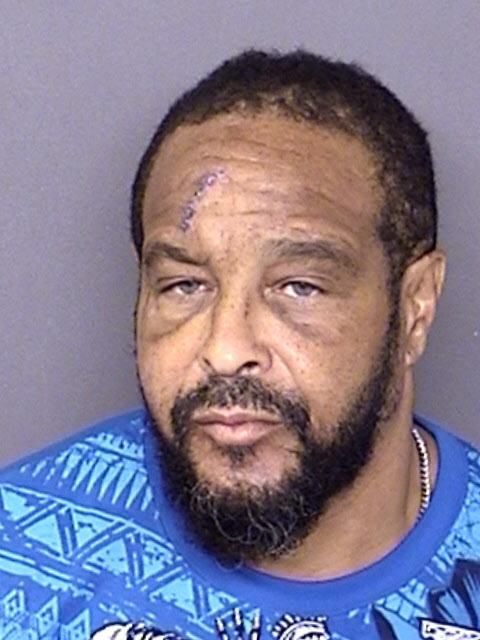
Mr. Anthony generally corroborated Mr. Dickerson’s account of the attack, testifying as follows:
“[MR. ANTHONY]: We came down the steps, was headed
back to the truck and they jumped out of the woods.
[THE STATE]: Who jumped out of the woods?
[MR. ANTHONY]: Joey Eckloff and [appellant].
[THE STATE]: And do you recall what each of those people were doing?
[MR. ANTHONY]: Just jumped out at us and start hollering get on the ground, get on the ground.
[THE STATE]: They were hollering get on the ground?
[MR. ANTHONY]: Yes, yes, ma’am.
[THE STATE]: And what did, what did [appellant] have in his possession, if you know?
[MR. ANTHONY]: I don’t honestly know other than I was told he had a gun.
[THE STATE]: Okay. But you don’t know that?
[MR. ANTHONY]: No, not, not—
[THE STATE]: Okay, so I don’t want you to speculate about—
[MR. ANTHONY]: —100 percent, no.
[THE STATE]: —anything.
[MR. ANTHONY]: Okay.
[THE STATE]: I just want to know what you know, what you saw.
[MR. ANTHONY]: Only thing I seen was a big stick.
[THE STATE]: Okay. You saw—excuse me?
[MR. ANTHONY]: A stick.
[THE STATE]: You saw the big stick?
[MR. ANTHONY]: Yeah, like a—
[THE STATE]: And who did you see with the big stick?
[MR. ANTHONY]: Joey Eckloff had it.
[THE STATE]: Okay. And did you see him do anything with the big stick?
[MR. ANTHONY]: Not to me, no.
[THE STATE]: What did he, did he, what did he—who did he do what to?
[MR. ANTHONY]: He hit [Mr.] Dickerson with it.
[THE STATE]: All right. And do you know why he hit [Mr. Dickerson]?
[MR. ANTHONY]: I don’t understand why he did because they had already gotten everything, but when he jumped, he jumped over top of me when [appellant] said, excuse my language, he said hit the mother fucker, so he jumped over and he hit him.
[THE STATE]: All right. So [appellant] told—[appellant] told [Eckloff] to hit the mother fucker?
[MR. ANTHONY]: Yes, ma’am.”
Eckloff threatened Mr. Anthony with the axe handle as though to hit him. Mr. Anthony saw Eckloff hit Mr. Dickerson three or four times.
Mr. Dickerson had injuries to the back of his head and one of his fingers. He was transported by helicopter to Prince George’s County Hospital, where he received Twentynine staples and thirteen stitches and was diagnosed with a chipped bone in his hand.
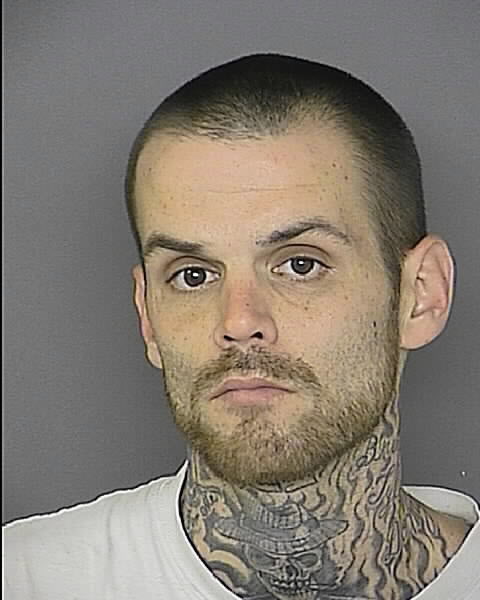
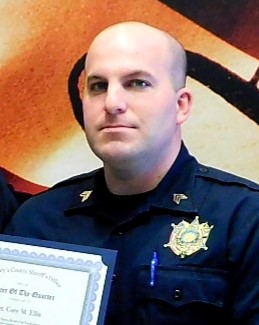
Detective Cory Ellis, the lead detective, testified that within two hours after the attack, he interviewed Mr. Dickerson at the hospital. He testified about Mr. Dickerson’s statements at the hospital as follows:
“[THE STATE]: And what, if anything, did you learn?
[DET. ELLIS]: He told me that he—
[APPELLANT’S COUNSEL]: Objection.
THE COURT: Overruled.
[DET. ELLIS]: I asked him how he had received the injuries that he was receiving treatment for. And he was able to tell me that he had received the injuries after leaving a house or an apartment that he had been at in the Wildewood area on Sugar Maple Court. He said after he was leaving the apartment with a friend of his, who he had told me was Michael Anthony, that two men came out of the woods or from behind a vehicle—he wasn’t sure which—and approached him.
One had what he believed was a handgun, and the other had some sort of a pole or a stick. He got into an altercation with the man that had the handgun, which resulted in both of them being on the ground; at which point he was hit in the head several times as well as the hand when he was trying to, I guess, defend himself, is what he said, which caused injuries to his hand and his head.
And after I think he said three to four blows, is what he remembers feeling, he gave up any sort of resistance or fighting. And the two suspects took a cell phone and money from his pockets.
[THE STATE]: Do you recall—and only if you know—do you recall how much money was taken from him?
[DET. ELLIS]: He said approximately $300 was in his pocket.”
Soon afterwards, the State asked for more details of the interview with Mr. Dickerson, but at that time the court sustained appellant’s objection on hearsay grounds, specifically rejecting that it fit the excited utterance exception to the hearsay rule.
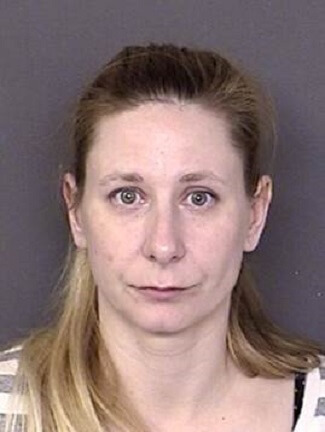
The detective also interviewed appellant, and the State introduced the recording of that interview. In the interview, appellant denied that he had been at Hockaday’s apartment that evening. Det. Ellis told appellant that the purpose of the interview was to determine “whether it was you, your intention just to go there, and try and tell the guy, Fucking leave Sara alone” or whether it was his intention to harm Mr. Dickerson. Det. Ellis told appellant that he believed “you probably weren’t the person that was intending to go there, and, and beat somebody up, to put him in the hospital. You were probably going there to say, Leave her the fuck alone.”
The State presented DNA evidence and cell phone mapping at trial. Eckloff, Hockaday, and Hockaday’s cousin did not testify at trial. Appellant elected not to testify and presented no evidence in a defense case. Joseph Eckloff and Sara Hockaday each pled guilty. Eckloff was sentenced to a term of incarceration of five years, Hockaday to a term of incarceration of eighteen months.
The trial court sentenced appellant to a term of incarceration of sixty years, twenty-five years for first-degree assault of Mr. Dickerson, twenty-five years consecutive with ten suspended for conspiracy to commit first-degree assault of Mr. Dickerson, and ten years consecutive, all suspended, for second-degree assault of Mr. Anthony. This timely appeal followed.
II.
Before this Court, appellant argues that the trial court erred in admitting hearsay statements from Det. Ellis, who testified as to his recollection of what the victim told him at the hospital. There was no hearsay exception into which the recollection fit, and the trial court later found as much when it denied the introduction of more information from the interview because it did not fit the excited utterance exception as the State claimed.
Appellant further maintains that the testimony was not harmless because it bolstered the testimony of the State’s key witness, Mr. Dickerson. Mr. Dickerson’s testimony differed from Mr. Anthony’s in ways that more strongly suggested an intent to injure the victims,1 and Det. Ellis repeated a more focused, easily understood narrative. Appellant maintains that this repetition by a police officer likely enhanced Mr. Dickerson’s credibility.
The State argues that Mr. Dickerson’s statement to the detective fit into the excited utterance hearsay exception, even though the trial court later ruled it was not an excited utterance because the victim was receiving medical treatment for his wounds suffered during the attack.
Assuming error arguendo, the State argues harmless error because the evidence was merely cumulative repetition. Because appellant did not seriously impeach Mr. Dickerson’s testimony, the reiteration could not have bolstered Mr. Dickerson’s credibility.
The prosecution’s opening statement also summarized the attack in the same manner as Det. Ellis’s testimony.
Both parties also argued the other questions presented, but because those issues were unpreserved, we will only consider the hearsay question which we find to be reversible error.2
Footnotes 1 & 2:
1
Mr. Dickerson testified that the attackers ran up and hit them, while Mr. Anthony said they told the victims to get on the ground. Mr. Dickerson’s testimony is also the only evidence that appellant said, “I’m going to kill you.”
2
In addition to the hearsay testimony related by Det. Ellis, appellant raises on appeal three other issues: the court’s response to a jury note inquiring about the elements of first-degree assault and the intent requirement, the propriety of the jury instruction as to accomplice liability, and the judge’s comments during sentencing about parole expectations. Because we conclude that the hearsay error was reversible error, and there was no objection below to the court’s comments and hence the issues are unpreserved, we note only briefly the facts related to those issues.
During deliberations, the jury sent a note, inquiring as follows: “For conspiracy to commit assault in the First Degree is it sufficient that there was conspiracy and 1st degree happened, or that the conspiracy had to include the level of injury planned.” The court responded: “The law says that the means by which the conspiracy was intended to be accomplished need not be set forth because a conspiracy does not require the degree of particularity required for the substantive offense.” Appellant’s counsel signed the court’s response to the note and did not object. Although not conceding error and asserting waiver, the State notes that the court’s response “could, in context, have led [the jury] to believe [appellant] need not have intended to inflict serious physical injury to be guilty of conspiracy.” If the issue had been preserved, we would have concluded that the court erred in its response to the jury note.
At sentencing, the State argued to the court that “whatever sentence that’s going to be, based on the way that they receive the credits, he is only going to serve half.” The court imposed a forty-year sentence, stating “you will serve probably half of that, maybe less if the Justice Reinvestment Act comes along for you.”
Court Ruling Continued:
Hearsay is defined as “a statement, other than one made by the declarant while testifying at the trial or hearing, offered in evidence to prove the truth of the matter asserted.” Maryland Rule 5-801. The State offered Mr. Dickerson’s out-of-court statements for the truth of the matter asserted. Det. Ellis’s testimony was inadmissible hearsay.
The State argued that the statement could fit into the excited utterance exception even though the interview commenced two hours after the assault because “time alone is not dispositive” of the exception. Marquardt v. State, 164 Md. App. 95, 128 (2005). We reject the State’s argument, as did the trial court, that the statement was an excited utterance. The foundation for excited utterance was lacking. We note that in Marquardt, a witness’sstatement was made half an hour after the relevant incident, and was determined not to be an excited utterance because there was no evidence “that she was reacting without deliberation.” Id. By the time of his interview with Det. Ellis, Mr. Dickerson had stated and then strategically changed his testimony. Because there is no hearsay exception to support the admission of this testimony, the court erred.
We hold that this error was not harmless beyond a reasonable doubt. The test for harmless error in Maryland was set out in Dorsey v. State, 276 Md. 638 (1976), and has not changed since then. The Court of Appeals explained as follows:
“[W]hen an appellant, in a criminal case, establishes error, unless a reviewing court, upon its own independent review of the record, is able to declare a belief, beyond a reasonable doubt, that the error in no way influenced the verdict, such error cannot be deemed ‘harmless’ and a reversal is mandated.
Such reviewing court must thus be satisfied that there is no reasonable possibility that the evidence complained of—whether erroneously admitted or excluded—may have contributed to the rendition of the guilty verdict.”
Id. at 659.
We cannot say beyond a reasonable doubt that the hearsay evidence did not contribute to the guilty verdict. The State suggests that the hearsay was cumulative, but it did more than simply repeat facts established elsewhere.
Maryland defines assault in the first degree in part as “intentionally caus[ing] or attempt[ing] to cause serious physical injury to another.” Maryland Code Ann., Crim. Law
§ 3-202(a)(1) (2002; 2012 Repl. Vol., 2016 Supp.). 3
For conspiracy or accomplice liability for first-degree assault, appellant needed to specifically intend serious physical injury. Mr. Dickerson’s and Mr. Anthony’s testimony contained discrepancies that could be relevant to specific intent. Mr. Dickerson said appellant immediately “jumped” or “got on” him, while Mr. Anthony said the attackers “jumped out at us and start[ed] hollering get on the ground.” Mr. Dickerson describes an attack, while Mr. Anthony’s description is consistent with a plan to rob or intimidate rather than injure. Mr. Dickerson also testified that his attacker said “I’m going to kill you,” while Mr. Anthony only heard appellant tell Eckloff to hit him as they struggled. A statement of intent to kill is more indicative of the necessary specific intent than calling for help during a fight.
3 Section 3-202(a)(2) adds assault with a firearm, but that is not relevant to this case.
Mr. Dickerson’s credibility was an issue in the case. The testimony of Mr. Dickerson and Mr. Anthony were not entirely consistent. Det. Ellis’s hearsay testimony repeated Mr. Dickerson’s recitation of the events and served no purpose other than to bolster Mr. Dickerson’s credibility. This repetition was not merely cumulative because it also increased Mr. Dickerson’s credibility, which could be especially important in determining which version of the attack to believe. The hearsay was not merely cumulative evidence.
The jury later reported difficulty in assessing the specific intent requirement. Any testimony that was relevant to specific intent, as Det. Ellis’s report of Mr. Dickerson’s statements was, could have impacted their verdict. It is not beyond a reasonable doubt that Det. Ellis’s hearsay in no way influenced their verdict.
Because we shall reverse and remand this case for a new trial, we need not consider appellant’s unpreserved arguments and plain error arguments related to the jury instructions, sufficiency of the evidence, and sentencing.
JUDGMENTS OF THE CIRCUIT
COURT FOR ST. MARY’S COUNTY
REVERSED. CASE REMANDED TO
THAT COURT FOR NEW TRIAL.
COSTS TO BE PAID BY ST. MARY’S
COUNTY.
Discover more from THE CHESAPEAKE TODAY - ALL CRIME, ALL THE TIME
Subscribe to get the latest posts sent to your email.

